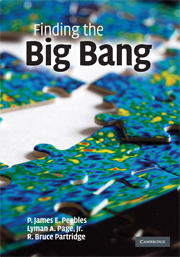5 - Cosmology and the CMBR since the 1960s
Published online by Cambridge University Press: 05 July 2015
Summary
This chapter was written in collaboration with J. Richard Bond
In 1970 we knew that space is filled with a near-uniform sea of microwave radiation, the CMBR. That was interesting, an addition to the list of what is known about the universe. But, as we have been discussing, there was reason to think that this was a particularly important find, a fossil left nearly undisturbed from a time when our universe was very different from now – dense, hot and rapidly expanding. The main piece of evidence was the spectrum – the variation of the intensity or energy in this radiation with wavelength – which was known to be close to the thermal form one would expect for radiation left undisturbed from hot early stages of an expanding universe. It was encouraging also for this hot big bang picture that it offered an explanation of another observation, the large abundance of the element helium, which could be another fossil remnant from the early universe. But in 1970 this big bang interpretation was a large conclusion about the nature of the universe to draw from the exceedingly limited set of evidence we could bring to bear. Perhaps the CMBR originated in some other way, possibly by processes operating in the universe as it is now, as in the steady state cosmology. Or perhaps the radiation came from a time when conditions were different from now but different also from standard ideas about the big bang.
The early exploration of alternatives to the idea of a hot big bang is reviewed beginning on page 34. Debates such as this are a normal and healthy part of science, and there is a standard procedure for resolving them: sift through the evidence, set about gathering more of it, and explore how it all might fit together. The process is a learning curve: by trial and error seek ways to develop improved trials that may on occasion show how to do even better, and then still better.
- Type
- Chapter
- Information
- Finding the Big Bang , pp. 408 - 477Publisher: Cambridge University PressPrint publication year: 2009



